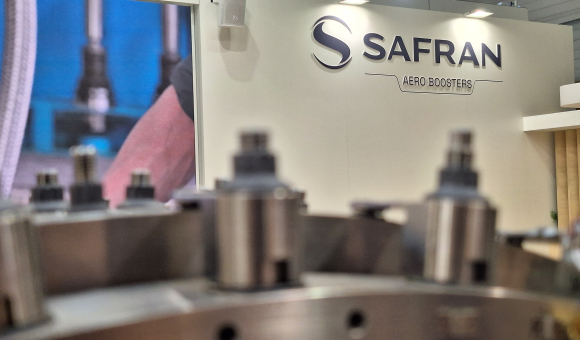
Belgium is well represented at the International Paris Air Show, with 55 exhibitors from the Walloon region, representing almost two-thirds of the 'Belgian Aerospace' delegation. This presence highlights the vitality and strength of the aerospace ecosystem, as underlined by Étienne Pourbaix, Director of the Skywin Aerospace cluster.

"The Belgian aerospace sector comprises more than 200 companies, generating some 11,000 direct jobs and posting sales of €2.8 billion. It relies on three Tier 1 suppliers, each a leader in its own sector, as well as a dynamic network of innovative and highly specialised SMEs. It’s also worth noting that many aerospace companies have subsidiaries in Belgium." – Etienne POURBAIX.
What notable changes have we seen in the number or profile of aerospace companies in recent years?
We’ve seen two key developments in recent years: on one hand, a consolidation of the sector; on the other, the emergence of new players – often from outside the traditional aerospace industry – bringing technological building blocks that enable them to integrate into the value chain. This has broadened the ecosystem in terms of expertise, without significantly changing the number of players.
In economic terms, the sector’s turnover has returned to pre-COVID levels. However, employment remains a challenge, with ongoing difficulties in recruiting both engineers and production staff.
What do you see as the key skills and areas of excellence?
Given its size, Wallonia can be proud to count two global leaders in their respective domains: Safran Aero Boosters and Sonaca. At the same time, thanks to a dynamic industrial ecosystem, a dense network of specialised SMEs, and strong collaboration with research centres and universities, Wallonia has developed expertise that is recognised on a European and international level. Among the region’s flagship areas of excellence, I would highlight:
- Precision mechanics, additive manufacturing, and the assembly of complex sub-systems.
- Advanced materials engineering.
- Embedded systems and electronics (cyber defence and securing critical systems).
- Testing, particularly Non-Destructive Testing (engines, hydraulic equipment, and structures) and digital simulation.
- MRO (maintenance of aeronautical and military equipment).
'Today, the scientific expertise and mastery of materials – such as metals and composites – combined with advanced simulation competences, have positioned Walloon companies as key partners of the world’s leading aircraft manufacturers' – Etienne POURBAIX.
Focus on Non-Destructive Testing
One of the key developments in Wallonia’s aerospace sector is the rise of Non-Destructive Testing (NDT) as a strategic area of expertise. A standout example is MPP, based in Herstal, which specialises in NDT for the aerospace industry and beyond.
Equipped with the latest NDT technologies whether in digital radiography, in cabins/bunkers (320 KV generator, 0.2 mm micro-focus tube and flat panel resolution from 50 to 200 µm), in digital radiography on customer sites (150 KV mobile generator), in magnetic inspection (latest generation magnetic bench), in Eddy current technics, in electrostatic Fluorescent Penetrant inspection, in ultrasonic inspection (phase array) and in thermography (high thermal sensitivity camera) – MPP has established itself as one of the world’s leading companies in the field of NDT.
Earth observation, the spearhead of Wallonia’s space industry
In the space sector, Wallonia stands out for its expertise in Earth observation, supported by innovative companies such as Aerospacelab. The Walloon space industry covers the entire value chain, with recognised expertise in technologies for reusable launchers, actuator design, structures, power electronics – for both launchers and satellites – and cybersecurity.
The JRI4Space initiative is also worth highlighting. This collaborative programme brings together universities, research centres, and industry players across Wallonia to align scientific priorities with the concrete needs of the space sector.
Decarbonising aviation: the WINGS project gives wings to sustainable innovation.
For the past five years, around twenty Walloon players – including major companies, SMEs, and research centres – have been collaborating under the “WINGS*” technological innovation partnership. Their shared mission? To accelerate the ecological and digital transformation of the aeronautical sector and support the deployment of a low-carbon aircraft by 2035, and a carbon-neutral aircraft by 2050.
Backed by strong regional government support, WINGS has generated a new level of collaborative momentum across the Walloon aerospace ecosystem. The programme addresses both:
- The aircraft itself: aerostructures, propulsion technologies, communication systems.
- Its production: materials and processes, digitalization – digital simulation, and Industry 4.0.

Walloon companies joined forces to conduct research aimed at furthering the ecological and digital transition of the aeronautics sector and meet the ambitious EU objective by putting a lowcarbon aircraft into service in 2035 and a carbon-free aircraft in 2050.
Faced with environmental challenges and ambitious plans for decarbonisation, ultra-frugality and then net-zero by 2050, we are experiencing an unprecedented acceleration in development and innovation cycles, as well as the development of so-called disruptive technologies. Walloon industry players are fully committed to this transition, working actively on breakthrough innovations in both propulsion and aerostructures (wings, fuselage, etc.), to contribute to the emergence of new-generation aircraft that are more sustainable, more efficient, and more respectful of the environment – Etienne POURBAIX.
Until now, Wallonia has primarily focused its efforts on decarbonising the aviation industry itself. However, airports also play a crucial role in achieving broader emission reduction targets. In this context, a new collaboration has been launched with the Société Wallonne des Aéroports (SOWAER) to develop a dedicated action plan for the decarbonisation of both air transport and airport infrastructure across the region. This initiative marks a strategic step towards a more holistic and sustainable aviation ecosystem in Wallonia.
Artificial intelligence, cybersecurity, high-performance computing, quantum technologies, etc.
These cutting-edge themes, prominently featured at Le Bourget, also lie at the core of Wallonia’s strategic priorities. Around ESA’s operational centre in Redu, a true technology hub is taking shape. This includes a cybersecurity centre and a quantum demonstrator, both emblematic of the region’s ambition to position itself as a leader in dual-use innovation – bridging civil and military advancements in key enabling technologies.
'Our companies cover the entire value chain, from digital simulation and design to Non-Destructive Testing. It’s also worth noting that the emergence of so-called ‘intelligent’ materials is expanding Walloon expertise into a hybrid discipline that merges mechanical and electronic engineering. Finally, the data economy and artificial intelligence are playing an increasingly strategic role, driving innovation and strengthening the sector’s competitiveness' – Etienne POURBAIX.
The defence sector is benefiting from a favorable context. What are the concrete benefits for Walloon companies?
The opportunity is real! The Belgian aerospace and defence sector is eager to join the European FCAS (Future Combat Air System) project as soon as possible because the benefits (in terms of technological development and production) would be significant for the entire sector.
Conclusion
In conclusion, I would simply say that we can be proud of the aerospace and defence expertise developed here in Belgium. Despite our country’s modest size, we have established ourselves as a trusted and respected partner on the international stage.
Article & visual©️Gate.31




